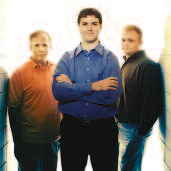The move from university housing to an off-campus apartment has become a rite of passage for many undergraduate students.
Curtis MacDonald has converted the cherished ritual into a business opportunity.
MacDonald, a major in Lehigh’s Integrated Business and Engineering (IBE) honors program, realized two years ago that moving off campus would require him to find another way to access the Internet.
Lehigh offers Internet access in its residence halls and at numerous wireless access points. But while still living on campus, MacDonald learned he would not be able to access Lehigh’s network after he moved off.
“I didn’t want to pay $40 a month to a network provider,” says MacDonald, who graduated in 2005, “and I found that many of my hallmates and friends didn’t either.”
MacDonald embraced the challenge. He rigged an empty soup can into a wireless adapter or “cantenna.” Not satisfied, he sought advice from his electrical engineering professors and then began devising an adapter that could expand the range of a wireless computing signal.
“I got to the point where I could connect from an apartment three or four blocks away from campus,” he says. “But I knew I needed to perfect the device before I moved.”
In 2004, MacDonald entered the annual Student Entrepreneurship Competition of Lehigh’s Integrated Product Development (IPD) program. Twenty to 30 student teams submit proposals at the annual event. Two or three receive a $2,000 grant to work on a prototype and proof of concept. The winners can recruit other students to their projects and offer them IPD course credits.
MacDonald won one of the awards and assembled a team of five IBE majors and a computer science student. Today, two years and several grants later, his company, hField Technologies Inc., has begun selling Wi-Fire, an adapter that boosts a wi-fi signal range to 1,000 feet, almost three times the range of similar products.
The Wi-Fire, no bigger than a computer mouse and a half-inch thick, clips to a laptop or desktop computer and has a cord that attaches to a USB port. The Wi-Fire is aimed at the nearest wi-fi access point; if a user does not know where that is, software inside the device orients the Wi-Fire in the optimal direction.
Wi-Fire’s secret?
“We use radio frequencies more effectively because we offer a built-in directional antenna,” says MacDonald, who concentrated in computer engineering as an IBE major. “The antenna increases the signal strength in the proper direction.”
In addition, says MacDonald, Wi-Fire allows users to connect to any standard 802.11b/g wireless access point. Competing products, he says, are “non-standard compliant” and require additional equipment to connect.
“With Wi-Fire, you can walk into any building with wireless and not only connect but do so with faster speed and greater consistency and from further away.”
Similar products contain stronger antennas but require adapters to be added, says MacDonald. And some products require assembly, even soldering, while Wi-Fire, which costs $150, is ready to use.
In 2005, hField received $15,000 from the Keystone Innovation Zone program (KIZ), a state initiative to generate job growth by supporting community-university partnerships. Soon after, Blake Kleintop, who earned a B.S. in IBE with a finance concentration in 2006, joined as chief operations officer. MacDonald became chief technical officer and Tom DiClemente, who earned a B.S. in civil engineering from Lehigh in 1974, committed investment to the company from Gran Sasso Ventures LP and signed on as CEO.
The KIZ grant and fund investment enabled hField to draft a business plan and build 50 devices, which were given to local college students to test. Using feedback from the students, hField made improvements to Wi-Fire.
In the summer of 2006, hField’s business plan earned it a $150,000 loan from the Lehigh-based Ben Franklin Technology Partners, which provides technical and marketing assistance to start-ups.
MacDonald attributes much of hField’s success to Lehigh’s IBE program, which prepares students for an economy and a job market that are becoming ever more global.
“IBE is four years of training in entrepreneurship. It gives you a strong background in business and engineering, which is good for start-ups as well as established corporations.”
HField began selling Wi-Fire in August 2006, targeting bookstores and regional college campuses. The company plans to market Wi-Fire nationally in 2007 and is developing two other new wireless technologies.
Also in August, MacDonald earned an M.Eng. in mechanical engineering from Lehigh, with a concentration in IPD. He and Kleintop have found that a start-up is not a 9-to-5 job.
“The hours we put in are beyond counting,” he says.
“I did count one week,” says Kleintop, “and I got to 90.”
The time is well-invested, says MacDonald.
“We didn’t scrimp or compromise, and we were able truly to create a superior product. If you can hold a product in your hands and realize you made something tangible out of nothing – how extraordinary that is.”


